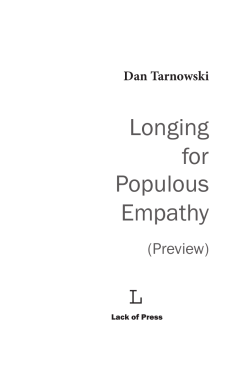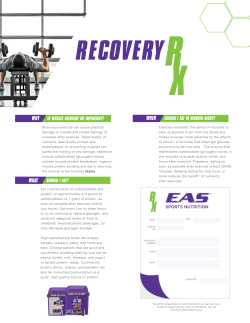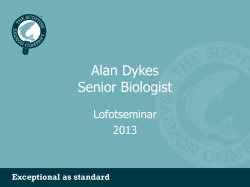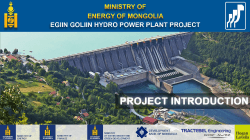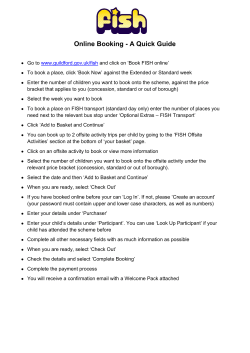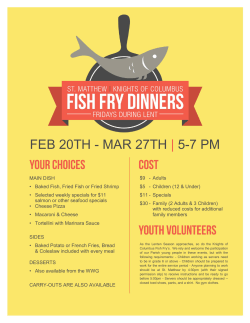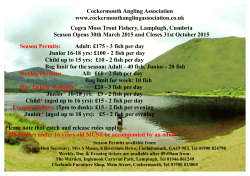
Effect of Organophosphorus Nuvan on Some Aspects of
Int. J. Pharm. Sci. Rev. Res., 31(2), March – April 2015; Article No. 14, Pages: 80-84 ISSN 0976 – 044X Research Article Effect of Organophosphorus Nuvan on Some Aspects of Carbohydrate Metabolism in Fresh Water Fish Labeo rohita (Hamilton) 1 2 3 P. Giridhar *, S.R.K. Neeraja , P. Indira Department of Zoology, Govt Degree College (M), Anantapur, Andhra Pradesh, India. 2 Department of Zoology, SSBN Degree College, Anantapur, Andhra Pradesh, India. 3 Department of Zoology, Sri Krishnadevaraya University, Anantapur, Andhra Pradesh, India. *Corresponding author’s E-mail: drpgiridhar@gmail.com 1 Accepted on: 07-02-2015; Finalized on: 31-03-2015. ABSTRACT Effect of sublethal concentration of Nuvan (0.011mg/ml) was studied on blood glucose, liver glycogen and muscle glycogen of the st th th th fish Labeo rohita. The blood glucose level elevated on 1 day exposure and gradually decreased on 7 day and 15 day. From 15 th day onwards their levels gradually elevated and came nearer to control at 30 day exposure period. In contrast to this the levels of liver and muscle glycogen followed an opposite trend. Keywords: Blood glucose, Labeo rohita, Liver glycogen and Muscle glycogen, Nuvan, Sublethal. INTRODUCTION Experimental Design O rganisms and its environment are two integral and inseparable, entities of an ecosystem. In an ecosystem organisms are subjected to environmental changes some of which are manmade. To boost the agricultural productivity for the massive growth of population, pesticides and chemical fertilizers are put into use. Pesticides are the biological toxicants which are required by man to kill insects, pests and also manʾs fight against the spread of diseases.1 Now pesticides usage became an indispensible and integral part of world agriculture. Modern agriculture practices even though contributed to enhance crop production, but also widely polluted aquatic environment.2 Agriculture practices along with pest control programmes, the surface runoff and aerial spraying forming the major source for translocating pesticides into aquatic ecosystems.3-5 The contamination of water by pesticides may effect on non - target organisms like fish.6-8 The fish is a good indicator and highly sensitive in such ecosystem where the water gets contaminated with toxic chemicals. So an attempt was made on sublethal effect of nuvan on some aspects of carbohydrate metabolism in the fish Labeo rohita. MATERIALS AND METHODS Test Chemical The pesticide selected for the present investigation was an Organophosphorus Nuvan. The active ingredient in Nuvan is Dichlorvos. It is widely used on diverse agricultural crops to control pests of crops, flies and mosquitoes. It has been widely used because of its degradability, non–persistent nature and low mammalian toxicity. Its commercial name was DDVP. Commercial grade was used and its effective concentration was 76%. Fresh water fish Labeo rohita, weighing 10±2 gm were procured from local fisheries department and stored in spacious aquaria. The water in aquaria was aerated twice day, the fish were fed daily with groundnut cake and rice bran. The physic-chemical properties of water used for experiments had pH 7.4 ± 0.2, dissolved oxygen 6-7 ml /lt, hardness 160 ppm and temperature 28±1˚C. Before experimentation has been executed, the fish were acclimated to the laboratory conditions for a period of 10 days. Later groups of 10 fish were exposed to different concentration of Nuvan ranging from 0.7 mg/ml to 1.4 mg/ml. The mortality was observed during 96 hrs exposure period. The LC50 / 96 hrs was determined from the percent and probit mortality versus log concentration curves9 and were subsequently verified by Dragstedt and Behrens method as given by Carpenter.10 After determination of LC 50/96 hrs (0.11mg/ml), the fish were exposed to sublethal concentration of Nuvan (1/10th of LC50/96hrs i.e. 0.011 mg/ml) for five exposure periods i.e 1, 7, 15 and 30 day. Methods In the present investigation the levels of blood glucose, liver glycogen and muscle glycogen were estimated in fish on 1,7,15 and 30 days of exposure to sublethal concentration of Nuvan besides controls. Each experiment was carried out in six individuals and the mean of six values were taken into consideration. The blood glucose levels were estimated by the Colorimetric 11 Micro-method as described by Mendel et al , liver glycogen and muscle glycogen were estimated by Colorimetric Anthrone method as described by Carrol et 12 al. International Journal of Pharmaceutical Sciences Review and Research Available online at www.globalresearchonline.net © Copyright protected. Unauthorised republication, reproduction, distribution, dissemination and copying of this document in whole or in part is strictly prohibited. 80 © Copyright pro Int. J. Pharm. Sci. Rev. Res., 31(2), March – April 2015; Article No. 14, Pages: 80-84 RESULTS In the present investigation the levels of blood glucose, liver glycogen and muscle glycogen were estimated in the fish on 1, 7, 15 and 30 days of exposure to sublethal concentration of Nuvan besides control levels were presented in tables 1, 2 and 3. The blood glucose level elevated relative to controls in fish at first day exposure and decreased gradually on 7 and 15 day exposure periods. From 15 day onwards their levels gradually elevated and came near to control at 30 day exposure period. The values were found to be significant (P<0.001). Whereas the levels of liver and muscle glycogen declined in fish at first day exposure period relative to controls. Their levels gradually elevated on 7 and 15 day exposure periods. From 15 day onwards their levels gradually declined and came near to control on 30 day exposure period. The percent change in glycogen content was more in liver than in muscle. The values were found to be significant (P<0.001). Table 1: Blood glucose levels (mg/100 ml of Blood) in the fish Labeo rohita on exposure to sublethal concentration of Nuvan. The percent change in the blood glucose levels at different periods was calculated in relation to the blood glucose levels in the control medium. The differences between control and exposure period days were found to be statistically significant (P < 0.001). Control Exposure period in days 1 day 7 day 15 day 30 day Mean 26.7 37.14 20.2 13.22 18.26 SD 0.82 0.65 0.72 0.54 0.68 +41.91 -23.11 -49.48 -30.22 PC SD – Standard Deviation; PC – Percent change Table 2: Liver glycogen levels (mg/gm wet. wt) in the fish Labeo rohita on exposure to sublethal concentration of Nuvan. The percent change in the liver glycogen levels at different periods was calculated in relation to the liver glycogen levels in the control medium. The differences between control and exposure period days were found to be statistically significant (P < 0.001). Control Exposure period in days 1 day 7 day 15 day 30 day Mean 18.06 13.36 22.51 24.47 13.16 SD 0.86 0.55 0.91 0.85 0.82 -26.02 +24.64 +35.49 -27.13 PC SD – Standard Deviation; PC – Percent change DISCUSSION Carbohydrates are essential component of living cells and are chief and immediate sources of energy for animals. They play a major role in the cellular metabolism by serving as fuel and providing energy to the cells. Fluctuations in oxygen consumption reflect fluctuations in energy demands of the animal, changes in carbohydrate ISSN 0976 – 044X metabolism that would meet the changing energy demands may be expected to stress.13,14 In vertebrates in general from fishes to mammal’s blood glucose level 15 corresponds to the standard metabolic rate. Table 3: Muscle glycogen levels (mg/gm wet. wt) in the fish Labeo rohita on exposure to sublethal concentration of Nuvan. The percent change in the muscle glycogen levels at different periods was calculated in relation to the muscle glycogen levels in the control medium. The differences between control and exposure period days were found to be statistically significant (P < 0.001). Control Exposure period in days 1 day 7 day 15 day 30 day Mean 1.22 1.02 1.29 1.42 0.81 SD 0.04 0.05 0.06 0.04 0.04 -16.39 +5.73 +16.39 -33.60 PC SD – Standard Deviation; PC – Percent change In this study relative to controls the blood glucose level elevated, where as the levels of liver glycogen and muscle glycogen decreased on first day exposure. The elevation in blood glucose level followed by decrease in the levels of liver and muscle glycogen on first day exposure indicates the high energy demand associated with imposed nuvan stress. To overcome this animal tends to mobilize the blood glucose by stimulating the glycogenolysis. Some of the observations were also supports the present trend in the elevation in blood glucose level.16-35 These entire studies shows shift in carbohydrates metabolism were observed when animals are exposed to toxicants. Similarly Sreenivasa and Indiran36 reported decrease in glycogen content in tissues of fish Oreochromis mossambicus on exposure to dimethoate. Lesley Sounderraj et al 37 reported significant elevation in blood glucose level in the frog Rana trigrina on exposure to lethal and sublethal concentration of phosphomidon. Fahmy38 observed decreased carbohydrate content in the teleost fish Oreochromis niloticus exposed to malathion. Suneetha39 observed decrease in glycogen content in various tissues of Labeo rohita on exposure to sublethal concentration of endosulfan and fenvalerate. Praveen et 40 al reported decrease in glycogen content in various tissues of fish Labeo rohita on exposure to sodium cyanide. Pratap and Singh41 observed significant decrease in glycogen level in Channa punctatus on exposure to sublethal concentration of λ – cyhalothrin. Ram Yadav and Ajay Singh42 reported decrease in glycogen content in tissues of snail Lymnea acuminata on exposure to plant pesticide. Arun Kumar and Jawahar Ali43 reported decrease in carbohydrate content in shrimp Streptocephalus dichotomus on exposure to sublethal concentration of malathion and glyphosate. Roopavathy 44 et al reported decline in glycogen content in different tissues of fish Oreochromis mossambicus on exposure to 45 malathion. Veeraiah et al reported depletion in International Journal of Pharmaceutical Sciences Review and Research Available online at www.globalresearchonline.net © Copyright protected. Unauthorised republication, reproduction, distribution, dissemination and copying of this document in whole or in part is strictly prohibited. 81 © Copyright pro Int. J. Pharm. Sci. Rev. Res., 31(2), March – April 2015; Article No. 14, Pages: 80-84 glycogen content in tissues of fresh water fish Cirrhinus mrigala on exposure to lethal and sub lethal concentration of cypermethrin. Magar and Dub46 reported that decrease in glycogen content in tissues of fish Channa punctatus on exposure to sublethal concentration of malathion. Suneel kumar47 reported significant decrease in liver glycogen content in the fish Channa punctatus on exposure to nuvan. Manoj Deshpande et al 48 reported depletion in glycogen content in tissue of fresh water crab Barytelphusa guerini on exposure to sumidon. ISSN 0976 – 044X REFERENCES 1. Gold B, Leuschen T, Brunk G, Gingell R, Metabolism of a DDT metabolite via a chlorohepoxide, Chem. Bio. Interact., 35, 1981, 159. 2. Pandey AC, Pandey AK, Das P, Fish and fisheries in relation to aquatic pollution In: Environmental Issues and management. S.R. Verma, A.K. Gupta and P. Das 9(Eds) Nature Conservators, Muzaffarnagar, 2000, 87-112. 3. Glotfelly DE, Majewski MS, Seiber JN, Distribution of several organophosphorus insecticides in a foggy atmosphere, Environ. Sci. Technol., 24, 1990, 353-357. 4. Roche H, Tidov A, Persic A, Organochlorine pesticides and biomarker responses in two fishes Oreochromis niloticus (Linnaeus, 1758) and Chrysichthys nigrodigtatus (Lacepede, 1803) and an invertebrate, Macrobrachium vollenhoveniil (Herkot, 1857), from the lake Taabo (Cote‘d Ivoire), J. Applied. Sci., 7, 2007, 3860-3869. 5. Joseph B, Raj SJ, Impact of pesticide toxicity on selected biomarkers in fishes, Int. J. Zool. Res., 7, 2011, 212-222. 6. Burkepile DE, Moore MT, Holland MT, Susceptibility of five non target organisms to aqueous diazinon exposure, Bull. Environ. Contam. Toxicol., 64, 2000, 114. 7. Saxena KK, Gupta P, Impact of carbamates on glycogen contents in the muscles of fresh water fish Channa punctatus, Poll. Res., 24, 2005, 669-670. 8. Dutta HM, Misquitta Doyglas, Khan Sanaaullah, The effect of endosulfan on the testis of blue gill fish Lepomis macrochirus. A Histopathological study, Archives, Environ. Contam. Toxical., 51(1), 2006, 149-156. 9. Finney DJ, Probit analysis, 2 Edn. Cambridge University Press, London, 1964. 10. Carpentor PL, In: Immunology and Serology. 3rd eds. W.B. Saunders Company, Philadelphia, London, Toronto, 1975, 254. 11. Mendel B, Kemp A, Mayers DK, A Calorimtric micro method for determination of glucose, Biochem. J., 56, 1954, 639645. Blood glucose level initially elevated on 1 day exposure followed by its inhibition on 7 and 15 day exposure periods. This is clearly evident by gradual elevation in liver and muscle glycogen up to 15day. In later half of exposure period the blood glucose level gradually elevated and came near to control on 30 day exposure period, where as the levels of liver and muscle glycogen gradually decreased and came near to control at 30 day exposure period. Metabolic compensation involves break down and synthesis of products necessary to cope up with altered situations 12. Caroll NV, Longley RW, Rose JH, Glycogen determination in liver and muscle by use of anthrone reagent, J. Biol. Chem., 220, 1956, 583-593. 13. Lacerda TP, Swaya P, Effect of two hypo osmotic conditions on haemolymph glucose concentration in Callinectes danae(Crustacea), Comp. Biochem. Physiol., 85(2), 1986, 509-512. 14. Santos EA, Nay LEM, Blood glucose regulation in an estuarine crab Chasmargnathus granulate (Dana, 1851) exposed to different salinities, Comp. Biochem. Physiol., 4, 1987, 1033-1035. CONCLUSION 15. In the present study the shifts in carbohydrate metabolism might be to compensate with situation shown by the fish for its survival to the imposed toxic stress. Umminger BL, Relation of whole blood sugar concentrations in vertebrates to standard metabolic rate, Comp. Biochem. Physiol., 56A, 1977, 457-460. 16. Pant J, Tewari H, Gill T, Effect of aldicarb on the blood and tissues of fresh water fish Barbus conchonius, Bull. Environ. Contam. Toxicol., 38, 1987, 36. 17. Radaiah V, Jayantha Rao K, Toxicity of pyrethroid insecticide fenvalerate to a fresh water fish T. mossambica In addition Nakano and Tomlinson49, Larsson50, Dalela et 51 52 al and Asztalos et al have suggested that adrenal hormones like glucocorticoids and catecholamines may be induced by pesticides, elevate the blood glucose level by conversion of stored glycogen into blood glucose. Koundinya and Ramamurthy53 reported hyperglycemia accomplished by decrease in the levels of glycogen in the liver and muscle of fish Sarotherodon mossambicus exposed to sumithion. David et al 54 suggested that carbohydrate metabolism disturbed when fish Labeo rohita exposed to pesticide fenvalerate. Neeraja and Giridhar55 reported decline glycogen content followed by elevation in blood glucose level in the fresh water fish Labeo rohita on exposure to deltamethrin. Bhattacharjee and Das56 reported decline in glycogen content followed by elevation in blood glucose level in fish Cyprinus carpio on exposure to lindane. Lakshmanan et al 57 reported that depletion in glycogen content in different tissues followed by elevation in blood glucose level of fish Oreochromis mossambicus on exposure to Dichlorvos. Israel Stalin and Sam Manohar Das58 reported initial decrease in liver glycogen content in various tissues and followed by its elevation in later exposure periods in the fish Cirrhinus mrigala on exposure to an organochloride fenthion. All these studies correlate initial elevation in blood glucose level followed by decrease in liver and muscle glycogen content. International Journal of Pharmaceutical Sciences Review and Research Available online at www.globalresearchonline.net © Copyright protected. Unauthorised republication, reproduction, distribution, dissemination and copying of this document in whole or in part is strictly prohibited. 82 © Copyright pro Int. J. Pharm. Sci. Rev. Res., 31(2), March – April 2015; Article No. 14, Pages: 80-84 (Peters), Ecotoxicol. Environment.Saf., 20(1), 1990, 117124. 18. 19. Nagendra Reddy A, Venugopal NBRK, Reddy SLN, Effect of endosulfan 35% EC on glycogen metabolism in the heamolymph and tissues of a fresh water field crab Barytelphusa guerini, Pestic. Biochem. Physiol., 40(2), 1991, 176-180. Jayaprada P, Reddy MS, Rao KVR, Subacute physiological stress induced by phosphomidon on carbohydrate metabolism in midgut gland of prawn, P. indicus. Biochem Inst., 23(3), 1991, 507-514. ISSN 0976 – 044X 33. Visvanathan P, Maruthannayagam C, Govinda Raju M, Effect of malathion and endosulfan on biochemical changes in Channa punctatus, J. Ecotoxicol. Environ. Monit., 19(3), 2009, 251-257. 34. Tilak KS, Veeraiah K, Lakshmi SK, Studies of some biochemical changes in the tissues of Catla catla, Labeo rohita, and Cirrhina mrigala(Hamilton) exposed to NH3N,NO2-N and NO3-N, J. Env. Biol., 23(4), 2002, 377-381. 35. Renuka MR, Andrews MI, Effect of nuvacron on carbohydrate metabolism of the green frog Euphlyctis hexadactylus, J. Ecobiol., 25(1), 2009, 39-44. 20. Somanath B, Effect of acute sublethal concentration of tannic acid on the protein, carbohydrate and lipid level in the tissue of the fish Labeo rohita, J. Environ. Bio., 12(2), 1991, 107-112. 36. Sreenivasa V, Indirani R, Impact of dimethoate on biochemical constituents in the fish Oreochromis mossambicus, J. Ecotoxical. Environ. Monit., 20(2), 2010, 151-156. 21. Govindan VS, Jacon L, Devika R, Toxicity and metabolic changes in Gambusia affinis exposed to phosphomidon, J. Ecotoxicol. Environ. Monit., 4(1), 1994, 1-6. 37. 22. Anitha Susan T, Veeriah K and Tilak KS, Biochemical and enzymatic changes in the tissues of Catla catla exposed to the pyrethroid fenvalerate, J. Ecobiol., 11(2), 1999, 109116. Lesley Sounderraj SF, Sekhar P, Senthil Kumar P, Nancy Lesley, Effect of systemic pesticide Phosphamidon on haematological aspects of common frog Rana tigrina, Int. J. Pharma. Biol. Archi., 2(6), 2011, 1776-1780. 38. Fahmy GH, Malathion toxicity: Effect of some metabolic activities in Oreochromis niloticus, the Tilapia fish, Int. J. Bio. Biochem and Bioinf., 2(1), 2012, 52-55. 23. Luther Das PN, Jayaprada P, Veeraiah K, Toxicity and effect of cypermethrin on biochemical constituents of fresh water teleost Channa punctatus, J. Ecotoxicol. Monit., 9(30), 1999, 197-203. 39. Suneetha K, Effect of endosulfan and fenvalerate on carbohydrate metabolism of the fresh water fish, Labeo rohita(Hamilton).), International Journal of Pharmacy and Pharmaceutical Sciences., 4(1), 2012, 262-268. 24. Kamble GB, Muley DV, Effect of acute exposure of endosulfon and chloropyrifos on the biochemical composition of the fish Sarotherondon mossambicus, Indian. J. Environ. science., 4(1), 2000, 97-102. 40. 25. Shoba Rani A, Sudharshan R, Reddy PVM, Raju TN, Effect of Sodium arsenate on glucose and glycogen levels in freshwater teleost fish, Tilapia mossambica, Poll. Res., 19(1), 2000, 129-131. Praveen Dube N, Shwetha A, Basaling BH, Effect of exposure to sublethal concentrations of sodium cyanide on the carbohydrate metabolism of the Indian Major Carp Labeo rohita (Hamilton, 1822), Pesq. Vet. Bras., 33(7), 2013, 914-919. 41. Sujay Kumar G, Reddy HM, Reddy SM, Phosphomidon induced changes in the glycolytic potentials of panaeid prawn M. monoceros, J. Acqua. Biol., 16(1), 2001, 71-76. Pratap B, Ajay Singh, In vivo Effects of Apigenin isolated from Jatropha gossypifolia plant on the biochemical profile of fish, Global Journal of Pharmacology., 7(2), 2013, 166171. 42. Bhavan SP, Geraldine P, Carbaryl induced alterations in biochemical metabolism of the prawn M. molcolmsonii, Journ. Env. Biol., 23(2), 2002, 157-162. Ram Yadav P, Ajay Singh, Toxic effects of selected plant pesticides against freshwater snail Lymnaea acuminate, Int. J. Trad. Nat. Med., 2(3), 2013, 149-163. 43. Arun Kumar MS, Jawahar Ali A, Toxic impact of two organophosphorus pesticides on Acetylcholinesterase activity and biochemical composition of fresh water fairy shrimp Streptocephalus dichotomous, Int. J. pharma. Biosci., (4)2, (B/P), 2013, 966-972. 44. Roopavathy J, Sukumaran M, Rengarajan R, Ravichelvan R, Narasiman N, Toxicity of Malathion on Metabolic Activities in the River Cauvery of Tilapia Fish (Oreochromis mossambicus), International Journal of Pharmaceutical & Biological Archives., 4(5), 2013, 986 – 989. 45. Veeraiah K, Vivek CH, Srinivas Rao P, Venkatrao G, Biochemical changes induced by cypermethrin (10%EC) a pyrethroid compound in sublethal and lethal concentrations to the fresh water fish Cirrhinus mrigala(Hamilton), J. Atoms and Molecules., 3(6), 2013, 625–634. 46. Magar RS, Dube KV, Effect of Sub Lethal Concentration of Malathion on Metabolic Profiles and Histological Studies in Heart Tissue of Channa Punctatus, IOSR Journal Of 26. 27. 28. Rawat DK, Bais VS, Agrawal NC, A correlative study on liver glycogen and endosulfan toxicity in Heteropneustes fossils, Journal of Environmental Biology., 23(2), 2002, 205-207. 29. Tilak KS, Wilson Raju P, Butchiram MS, Effects of alachlor on biochemical parameters of the freshwater fish, Channa punctatus (Bloch), Journal of Environmental Biology., 30(3), 2009, 421-426. 30. Jee LH, Masroor F, Kang J, Response of cypermethrininduced stress in haematological parameters of korean rock fish, Sebastes schlegli (Hilgendorf), Aquaculture Research., 36, 2005, 898-905. 31. Thenmozhi K, Effect of phosphomidon on blood glucose of the Indian skipper frog Rana cyanoplyctis, J. Exotoxicol. Enviro. Monit., 18(2), 2008, 153-156. 32. Muthukumaravel K, Murthy A, Blood glucose level and hepatic glycogen interrelationships in Labeo rohita exposed to heavy metal chromium, J. Ecobiol., 25(4), 2009, 307-310. International Journal of Pharmaceutical Sciences Review and Research Available online at www.globalresearchonline.net © Copyright protected. Unauthorised republication, reproduction, distribution, dissemination and copying of this document in whole or in part is strictly prohibited. 83 © Copyright pro Int. J. Pharm. Sci. Rev. Res., 31(2), March – April 2015; Article No. 14, Pages: 80-84 Environmental Science, Toxicology And Food Technology., 2(6), 2013, 08-12. 47. 48. 49. 50. 51. 52. Suneel Kumar, Acute toxicity evaluation of nuvan in liver of Channa puncatus (Bloch), Adv. Res. Agri. Vet. Sci., 1(3), 2014, 35-38. Manoj Deshpande, Nagesh Nagthane, Increased Carbohydrate Metabolism in Freshwater Crab, Barytelphusa Guerini Exposed to Sumidon Stress, from Godavari Basin, Nanded, Maharashtra, International Journal of Research Studies in Biosciences., 2(11), 2014, 133-137. Nakano T, Tomlinson N, Catecholamines and carbohydrate concentrations in rain bow trout S. gairdeneri in relation to physical disturbance, J. Fish. Res. Bd., Canada, 24, 1967, 1701-1715. Larsson A, Metabolic effect of epinephrine and norepinephrine in the eel Anguilla anguilla.L, Gen. Comp. Endocrinol., 20, 1973, 155-167. Dalela RC, Ravi S, Kumar V, Verma SR, In vivo haematalogical alternations in a fresh water teleost Mystus following sub acute exposure to pesticides and their combinations, J. Environ. Biol., 2, 1981, 79-86. Asztolas B, Nemasok J, Benedeezky Gabrial R, Szabo A, Refarieo J, The effect of pesticides on some biochemical parameters of carp C. carpio, Arch. Environ. Contam.Toxicol., 19, 1990, 257-280. ISSN 0976 – 044X 53. Koundinya PR, Ramamurthy R, Haemotological studies in S. mossambicus(Peters) exposed to sublethal concentration of sumithion and sevin organophosphates, Curr. Sci., 48, 1979, 832. 54. David M, Shivakumar R, Mushegeri SB, Kuri RC, Blood glucose and glycogen levels as indicator of stress in the fresh water fish Labeo rohita under fenvalerate intoxication, J. Ecotoxical. Environ. Monit., 15(1), 2005, 0105. 55. Neeraja SRK, Giridhar P, Impact of Deltamethrin on some aspects of carbohydrate metabolism in fresh water fish Labeo rohita, International Journal of Advanced research., 2(6), 2014, 361-366. 56. Bhattacharjee D, Suchismita Das, Toxicity of organochlorine pesticide, Lindane to fish, A review Journal of Chemical and Pharmaceutical Research., 5(4), 2013, 90-96. 57. Lakshmanan S, Rajendran A, Sivasubramaniyan C, Impact of Dichlorvos on tissue glycogen and protein content in freshwater fingerlings, Oreochromis mossambicus (Peters), International Journal of Research in Environmental Science and Technology., 3(1), 2013, 19-25. 58. Israel Stalin S, Sam Manohar Das S, Biochemical changes in certain tissues of Cirrhina mrigala (Hamilton) exposed to fenthion, Int. J. Environ. Sci., 2(3), 2012, 1268-1277. Source of Support: Nil, Conflict of Interest: None. International Journal of Pharmaceutical Sciences Review and Research Available online at www.globalresearchonline.net © Copyright protected. Unauthorised republication, reproduction, distribution, dissemination and copying of this document in whole or in part is strictly prohibited. 84 © Copyright pro
© Copyright 2025
